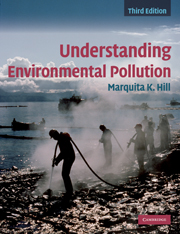Book contents
- Frontmatter
- Contents
- Preface
- Acknowledgements
- List of abbreviations and acronyms
- 1 Understanding pollution
- 2 Reducing risk, reducing pollution
- 3 Chemical toxicity
- 4 Chemical exposures and risk assessment
- 5 Air pollution
- 6 Acid deposition
- 7 Global climate change
- 8 Stratospheric ozone depletion
- 9 Water pollution
- 10 Drinking-water pollution
- 11 Solid waste
- 12 Hazardous waste
- 13 Energy
- 14 Persistent, bioaccumulative, and toxic
- 15 Metals
- 16 Pesticides
- 17 Pollution at home
- 18 Zero waste, zero emissions
- 19 Chemistry: some basic concepts
- Index
- References
14 - Persistent, bioaccumulative, and toxic
Published online by Cambridge University Press: 05 June 2012
- Frontmatter
- Contents
- Preface
- Acknowledgements
- List of abbreviations and acronyms
- 1 Understanding pollution
- 2 Reducing risk, reducing pollution
- 3 Chemical toxicity
- 4 Chemical exposures and risk assessment
- 5 Air pollution
- 6 Acid deposition
- 7 Global climate change
- 8 Stratospheric ozone depletion
- 9 Water pollution
- 10 Drinking-water pollution
- 11 Solid waste
- 12 Hazardous waste
- 13 Energy
- 14 Persistent, bioaccumulative, and toxic
- 15 Metals
- 16 Pesticides
- 17 Pollution at home
- 18 Zero waste, zero emissions
- 19 Chemistry: some basic concepts
- Index
- References
Summary
“Sustainable development simply means ‘treating the Earth as if we intended to stay.’”
Crispin Tickell, British Ambassador to the United NationsSection I of this chapter examines general characteristics of those chemicals that are persistent, bioaccumulative, and toxic (PBT). We see that even at low environmental levels, they can present problems. Section II looks at actions society is taking to reduce the risk of PBTs. Because all the PBTs we examine in this chapter are organic, the acronym POPs (persistent organic chemicals) is also used. Section III examines three families of PBT chemicals: one polychlorinated, one polybrominated, and one polyfluorinated (Box 14.1).
SECTION I
Tens of thousands of chemicals are in commercial use. Of these, the US EPA has identified 31 as PBTs (28 organic chemicals plus three metals and their compounds). Other PBTs may be identified in future screenings. Thirty-one out of thousands is a small number, but given their ability to cause problems we can be grateful there are relatively few. Industrialized countries banned several of the worst polychlorinated chemicals such as DDT and PCBs in the 1970s and 1980s. Over time, the levels of persistent chemicals have slowly fallen. But hot spots remain, and advisories exist not to eat fish caught in the Great Lakes and certain other waters. The US EPA continues to develop action plans to reduce the level so f specific PBTs. The Stockholm Convention of 2000 banned or greatly restricted 12 polychlorinated chemicals, dubbed the “dirty dozen.” PBTs also often move among air, water, and land, and cross human boundaries.
- Type
- Chapter
- Information
- Understanding Environmental Pollution , pp. 410 - 424Publisher: Cambridge University PressPrint publication year: 2010



